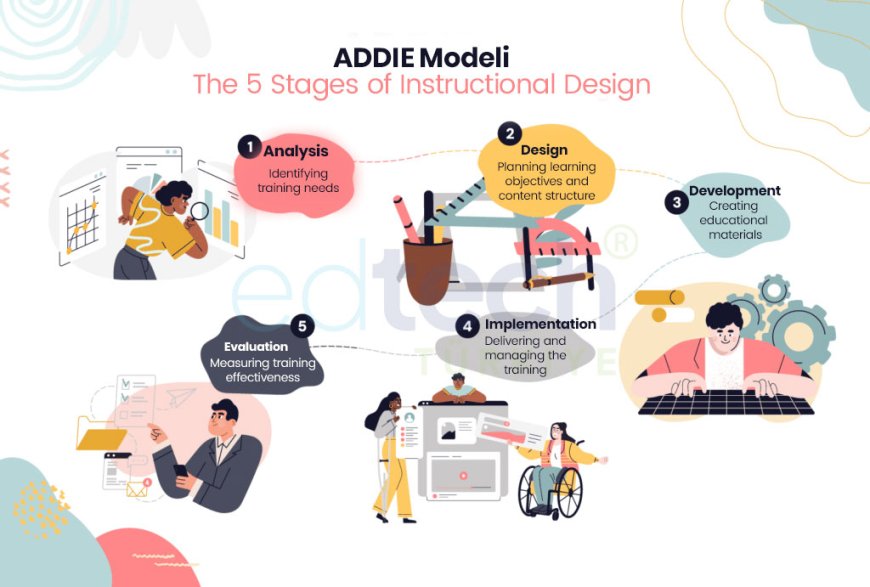ADDIE Model: The 5 Stages of Instructional Design
Discover the ADDIE Model, a structured instructional design framework used for effective corporate training and e-learning. Learn its five stages—Analysis, Design, Development, Implementation, and Evaluation—and how to apply them in workplace learning for better outcomes.

Hello EdTech Turkey Readers,
In the ever-evolving world of digital learning, designing effective and structured educational experiences has become more crucial than ever. One of the most widely used models that enhances efficiency, structures processes, and makes outcomes measurable in instructional design is the ADDIE Model.
ADDIE stands for Analysis, Design, Development, Implementation, and Evaluation—a systematic instructional design approach used to plan and deliver learning content effectively.
In this article, we will explore each phase of the ADDIE Model in detail and discuss how it can be applied in corporate training with real-world examples.
What is the ADDIE Model?
The ADDIE Model is a systematic instructional design framework used by instructional designers, educators, and corporate learning and development (L&D) teams.
The model consists of five key phases:
1️⃣ Analysis – Identifying training needs
2️⃣ Design – Planning learning objectives and content structure
3️⃣ Development – Creating educational materials
4️⃣ Implementation – Delivering and managing the training
5️⃣ Evaluation – Measuring training effectiveness
This structure ensures continuous improvement throughout the training process, covering all aspects from inception to evaluation.
1. Analysis Phase
This phase forms the foundation of the training process by answering key questions such as:
✅ What business problem are we trying to solve?
✅ What skills do employees need?
✅ What is their current knowledge level?
✅ Who is the target audience?
✅ What resources are available for training?
Application in Corporate Training:
- Skill Gap Analysis – Identify employees' current competencies.
- Surveys & Feedback – Gather direct input from employees and managers.
- Business Process & Performance Analysis – Align training needs with business performance.
Output: A needs analysis report defining training objectives, scope, and resource requirements.
2. Design Phase
This stage determines how training will be structured and what content will be included.
Application in Corporate Training:
✅ Setting Learning Objectives – Use SMART goals to clarify learning outcomes.
✅ Structuring Training Modules – Define topics, curriculum, and learning pathways.
✅ Storyboard & Scenario Development – Plan how content will be presented.
✅ Multimedia Selection – Choose appropriate formats such as videos, interactive modules, and animations.
✅ Assessment Strategy – Define how success will be measured.
Output: Storyboards, content outlines, and clearly defined learning objectives.
3. Development Phase
At this stage, designed learning materials are created and finalized.
Application in Corporate Training:
✅ Developing E-Learning Modules & Presentations – Create digital training content.
✅ Interactive Learning Tools – Integrate quizzes, simulations, and role-playing activities.
✅ Quality Assurance (QA) Testing – Test for errors and refine content as needed.
✅ Technical Compatibility – Ensure seamless integration with LMS and other platforms.
Output: Fully developed, tested, and ready-to-launch training materials.
4. Implementation Phase
This phase involves delivering the training program to employees.
Application in Corporate Training:
✅ Training Announcements & Participant Communication – Inform employees about the training and how to access it.
✅ Publishing via LMS or Online Platforms – Upload training materials to the designated platform.
✅ Technical Support & User Experience Monitoring – Address potential technical issues and ensure a smooth learning experience.
✅ Initial Reactions Measurement – Use surveys and feedback forms to gauge first impressions.
Output: A fully launched training program accessible to employees.
5. Evaluation Phase
This stage assesses whether the training met its objectives and identifies areas for improvement.
Application in Corporate Training:
✅ Collecting Participant Feedback – Measure employee experience through surveys and evaluation forms.
✅ Performance Analysis – Assess the impact of training on business results.
✅ Continuous Improvement – Update training programs based on feedback and analysis.
Output: Reports measuring training effectiveness and recommendations for enhancement.
Benefits of the ADDIE Model
- Provides a systematic and repeatable process.
- Offers a flexible structure adaptable for corporate training.
- Ensures structured and measurable learning experiences.
- Directly links training outcomes to business performance.
ADDIE Model Example: CRM Training for a Sales Team
| Phase | Example: CRM System Training |
|---|---|
| Analysis | Sales team struggles with CRM usage; goal is to speed up the sales cycle. |
| Design | Short e-learning modules, interactive scenarios, and live sessions planned. |
| Development | Videos, infographics, and simulation-based exercises created. |
| Implementation | Training deployed via LMS, with managers tracking employee progress. |
| Evaluation | CRM adoption rates, sales efficiency, and employee feedback measured. |
EdTech Turkey Insight
The ADDIE Model is a powerful instructional design framework that optimizes corporate training processes. For organizations leveraging digital learning strategies, it provides a structured roadmap to ensure effective learning outcomes.
Note:
For more details or to request a custom training program, feel free to contact us. Our expert team is ready to assist you!
Copyright Notice:
All content on this website is protected by copyright laws. Unauthorized copying, distribution, or reproduction is strictly prohibited. All rights reserved.